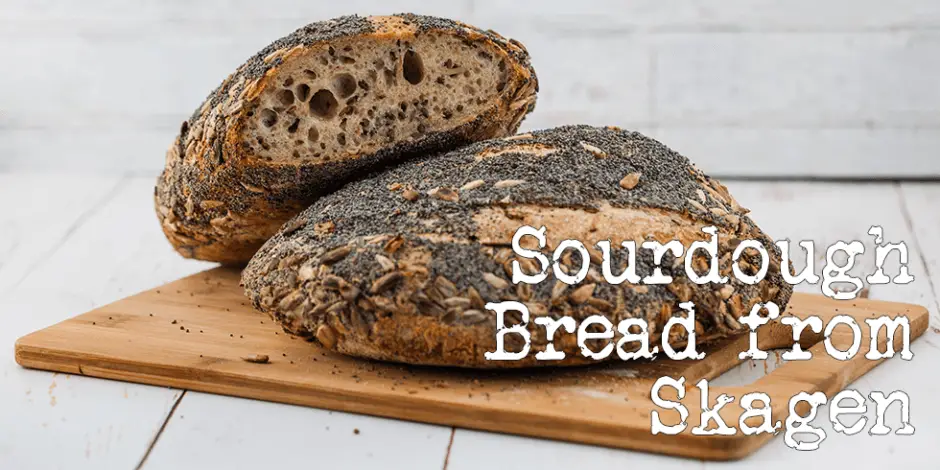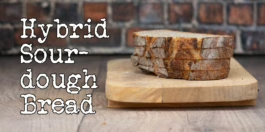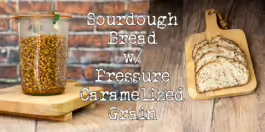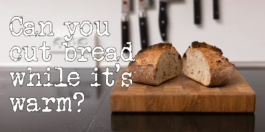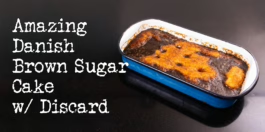My favorite kind of bread is without any doubt a sourdough bread from Skagen. Big holes in the crumb, lightly tangy, crunchy crust, and poppy seeds and sunflowers that are toasted because of the baking. This is my recipe for sourdough bread from Skagen heavily inspired by Maurizio Leo’s recipe for Seeded Sourdough.
If you are just here for the recipe, you can press the button underneath to be automagically transported to the recipe:
Jump to RecipeYou need an active sourdough starter for this sourdough bread from Skagen recipe
To bake this bread you will need an active sourdough starter. If you don’t have one, I’d recommend you go watch my video on YouTube.
A sourdough starter contains natural yeast, that will help your bread to rise without the use of commercial yeast, which means that you can make awesome bread with three ingredients: flour, water, and salt.
It’s not very hard to make a sourdough starter, but there are some things you need to be aware of. I will explain it all.
Special techniques for better bread
This is an advanced recipe. It takes about 24 hours from start to finish and requires some next-level techniques. if you follow this recipe it will vastly exceed anything you get at a bakery.
If you are new to sourdough baking, maybe you want to start somewhere where it’s a bit easier. You can try my “The world’s easiest sourdough bread” or “Sourdough bread for beginners“. That should get you started.

Tools that will make things easier
You need some tools to be able to bake sourdough bread.
Ad Links
The links for ingredients/items in this section are affiliate links,
which means I will get a commission if you purchase the product!
- Bench scraper – this is the only tool you can’t do without. You will absolutely need a bench scraper
- Danish dough whisk – you can use your hands or a spoon if you don’t want this
- Bannetons – you can use a bowl lined with a dishtowel as a substitute
- Spray bottle – I use this for spraying bannetons, spraying loaves to get seeds to stick, and saturating the oven with steam
- Brød and Taylor Folding Proofer – I own this and it is a huge help in making sure your dough has the best opportunity to proof
The road to awesome bread
I hope you will try my recipe for sourdough bread from Skagen. It’s an experience and when you cut into the loaf and see the crumb you be so happy. Okay, you may not be able to put jam directly on the bread, but you can always put a piece of cheese underneath to hold the jam. Not really a trade-off for me.
Please share this recipe for sourdough bread from Skagen on social media
This is my recipe for sourdough bread from Skagen. If you like the recipe please consider sharing it with like-minded bread lovers on social media.
If you make it and post it on Instagram, please tag me as @foodgeek.dk so I can see it. That would make me very happy.
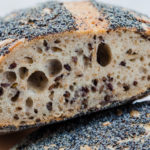
Sourdough Bread from Skagen
Ingredients
Levain
- 25 gram sourdough starter 50%
- 25 gram bread flour 50%
- 25 gram whole wheat flour 50%
- 50 gram water 100%
Dough
- 673 gram bread flour 76,5%
- 140 gram semolina flour 15,9%
- 67 gram whole wheat flour 7,6%
- 644 gram water 73,2%
- 19 gram fine salt 2,2%
- 88 gram poppy seeds 10,0%
- 51 gram sunflower seeds 5,8%
Toppings
- poppy seeds
- sunflower seeds
Instructions
Levain – About 9:00/9 a.m.
- Make the levain by mixing bread flour, whole grain wheat flour, water, and mature sourdough starter in a big enough container to grow to about twice the size. Your starter must be super active and bubbly.
- Put it somewhere warm and let the starter do its job.
Autolyse – About 15:00/3 p.m.
- Weight out and mix all three flours.
- Measure out 544 grams of water.
- Add the water to the flour and mix it so that all the flour is completely hydrated. I usually use a Danish dough whisk to mix in the beginning, and when the dough comes together, I fold the dough over itself until it's mixed.
- Put a dishcloth over the top and put it somewhere warm.
Soak the seeds- About 15:10/3.10 p.m.
- Put the poppy seeds and sunflower seeds in a bowl, pour 150 grams of boiling water over and let them soak.
Make the dough – About 17:00/5 p.m.
- Put the levain over to the top of the dough. Mix it thoroughly.
- When you have mixed the dough, it's time to build some gluten in it using some stretch and folds.
- Put the bowl in front of you. Grab the dough in the back of the bowl with both hands. Stretch it as far as it goes without tearing, and fold it down over the dough.
- Turn the bowl about 1/8 and repeat about 30 times.
- Spread the salt over the dough and pour 100 grams of water over and mix it into the dough.
- Let the dough rest for 30 minutes, then we will be doing five stretch and folds every half hour.
First stretch and fold – About 17:40/5.40 p.m.
- Do a stretch and folds the following way:
- Do a stretch and fold and turn the bowl 180°.
- Do a stretch and fold and turn the bowl 90°.
- Do a stretch and fold and turn the bowl 180°.
- Do a stretch and fold. Now you've done one from each direction.
- Put a dishcloth over the top and let the dough rest.
Second stretch and fold – About 18:10/6.10 p.m.
- Do a stretch and fold as described above.
- Spread the seeds over the top and blend them into the dough using wet hands.
Third to fifth stretch and fold – About. 18:40./6.40 p.m., 19:10/7.10 p.m., 19:40/7.40 p.m.
- Do a stretch and fold as described above; after the fifth, let the dough rest.
Divide and preshape – About 20:50/8.50 p.m.
- Pour the dough out onto an unfloured table.
- Divide the dough in half.
- I use my bench scraper to move the dough because it can be pretty wet.
- I usually do a preshape the following way:
- Push the scraper under the dough in the front. Stretch it up and fold it about three quarters in over the dough. Repeat from the top, right, and left side.
- Push the scraper under the dough and flip it over, so the top is down towards the table.
- Put the scraper behind the dough and move it forward. The front of the dough will be pushed under the ball and create tension on the top of the dough.
- When you can't get any further, then hold the dough lightly and pull the scraper away from the dough.
- Then place the scraper in front of the dough and push forward; while moving, turn it around, and pull it towards yourself again. Keep going until the dough is very tight.
- Continue with the other dough ball and let them rest under a damp dishcloth
Shaping of the dough
- Prepare a dishcloth with poppy seeds and sunflower seeds in one layer. These seeds shouldn't be soaked.
- To shape the dough, follow the instructions from the preshape.
- When you've shaped the dough, spray it with some water from the spray bottle; flip it onto the dishcloth. Roll it around to get seeds on the top and the sides.
- Then move it to a banneton lined with a dishtowel.
- Repeat with the other dough ball.
Rest and retard in the fridge – About 21:15/9 p.m.
- Put both bannetons in plastic bags and put them in the fridge until the following day.
Heat the oven – About 6:15/6.15 a.m.
- If you have a baking steel or a pizza stone, put it in the oven. It'll help keep the temperature constant even when you open the oven door.
- Put your dutch oven or combo cooker in the oven and heat it to 260ºC/500ºF. If your oven doesn't go this high, put it as high as possible.
Bake the breads – About 7:15/7.15 a.m.
- Take a loaf out of the fridge.
- Cut parchment paper about the same size as the bread and put it on the banneton. Turn it over to a peel or something that can help you move the dough to the oven later.
- Score the dough using a very sharp knife. If you cut at an angle, you can get a beautiful ear.
- Open the oven and put the dough in the dutch oven. Be careful, it's hot, and it can be challenging to get in. I use a combo cooker because you can turn it upside down and put the dough in the "frying pan" part.
- Put the lid on top and push it into the oven—bake for 20 minutes.
- Open the oven and take the top off the dutch oven so that the crust can get some color.
- Turn the oven down to 230ºC/450ºF and bake until you have a beautiful golden crust. 25-30 minutes.



